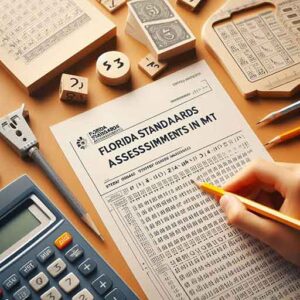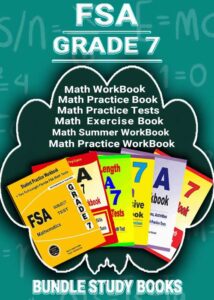
Study Time: 4minutes
What is the FSA Math?
The Florida Standards Assessments (FSA) Math is a standardized test administered to students in Florida to evaluate their proficiency in mathematics. The FSA Math test assesses how well students have mastered the Florida Standards in Mathematics, providing valuable insights into their readiness for future academic challenges. This article provides an in-depth look at the FSA in Math, including its purpose, structure, key topics, and preparation strategies.
The FSA Math measures students’ mathematical skills and knowledge. It is an essential tool for educators, parents, and policymakers to understand students’ strengths and areas for improvement. By assessing students’ performance against the Florida Standards, the FSA helps ensure that students are on track to succeed in their educational journeys.
Purpose of the FSA Math
Assessment of Student Proficiency
The primary purpose of the FSA in Math is to assess student proficiency in mathematics based on the Florida Standards. These standards outline the skills and knowledge students should acquire at each grade level, ensuring a consistent and rigorous education across the state.
Informing Instruction
FSA Math results provide valuable data that educators can use to inform instruction. By identifying areas where students excel or struggle, teachers can tailor their teaching strategies to meet the needs of their students and improve overall learning outcomes.
Accountability and Improvement
The FSA in Math also serves as a tool for accountability, helping schools and districts measure their effectiveness in delivering high-quality education. The results can drive school improvement initiatives and ensure that resources are allocated to areas that need the most support.
Structure of the FSA Math Test
Grade Levels Tested
The FSA Math test is administered to students in grades 3 through 8. Each grade level has a specific set of standards and topics the test covers, ensuring that the assessment is developmentally appropriate and aligned with the curriculum.
Test Format
The FSA Math test includes a variety of question types to assess different aspects of mathematical understanding and problem-solving skills. These question types may consist of:
- Multiple-choice questions: Students select the correct answer from a list of options.
- Multiple-Select Questions: Students select all correct answers from a list of options.
- Grid-In Responses: Students enter their answers in a grid.
- Equation Editor Responses: Students use an on-screen editor to enter equations or expressions.
- Fill-in-the-Blank Questions: Students provide the answer in a blank space.
Computer-Based Testing
Most students take the FSA Math test on a computer, allowing for interactive question formats and tools to aid in problem-solving. However, paper-based versions are available for students who require them as part of their accommodations.
Key Topics Covered in the FSA Math Test:
Grade 3
- Operations and Algebraic Thinking: Understanding multiplication and division, representing and solving problems.
- Number and Operations in Base Ten: Using place value to perform multi-digit arithmetic.
- Number and Operations – Fractions: Understanding fractions as numbers.
- Measurement and Data: Solving problems involving measurement and estimation.
- Geometry: Reasoning with shapes and their attributes.
Grade 4
- Operations and Algebraic Thinking: Using the four operations with whole numbers to solve problems.
- Number and Operations in Base Ten: Generalizing place value understanding for multi-digit numbers.
- Number and Operations – Fractions: Building fractions from unit fractions.
- Measurement and Data: Representing and interpreting data.
- Geometry: Drawing and identifying lines and angles.
Grade 5
- Operations and Algebraic Thinking: Writing and interpreting numerical expressions.
- Number and Operations in Base Ten: Performing operations with multi-digit whole numbers and decimals.
- Number and Operations – Fractions: Using equivalent fractions to add and subtract fractions.
- Measurement and Data: Converting units within a given measurement system.
- Geometry: Understanding the concept of volume.
Grade 6
- Ratios and Proportional Relationships: Understanding ratio concepts and using ratio reasoning.
- The Number System: Applying and extending previous understandings of numbers.
- Expressions and Equations: Writing and solving equations and inequalities.
- Geometry: Solving real-world problems involving area, surface area, and volume.
- Statistics and Probability: Developing an understanding of statistical variability.
Grade 7
- Ratios and Proportional Relationships: Analyzing proportional relationships and using them to solve problems.
- The Number System: Performing operations with rational numbers.
- Expressions and Equations: Solving real-life and mathematical problems using numerical and algebraic expressions.
- Geometry: Drawing, constructing, and describing geometrical figures.
- Statistics and Probability: Using random sampling to draw inferences about a population.
Grade 8
- The Number System: Knowing that some numbers are not rational and approximating them.
- Expressions and Equations: Working with radicals and integer exponents.
- Functions: Defining, evaluating, and comparing functions.
- Geometry: Understanding congruence and similarity using physical models or software.
- Statistics and Probability: Investigating patterns of association in bivariate data.
Preparation Strategies for the FSA Math Test
Review the Florida Standards
Understanding the Florida Standards for your grade level is crucial. These standards outline the specific skills and knowledge you need to master. Reviewing them can help you identify key areas to focus on during preparation.
Practice with Sample Questions
Using sample questions and practice tests is one of the best ways to prepare for the FSA Math test. These resources familiarize you with the format and questions you will encounter. Practice tests also help you identify your strengths and weaknesses, allowing you to focus your study efforts effectively.
Use Online Resources
Many online resources help you prepare for the FSA Math test. Websites offer interactive practice questions, video tutorials, and study guides that can enhance your understanding of complex topics.
Focus on Weak Areas
Identify the areas where you struggle the most and dedicate extra time to practice and review these topics. Use resources like textbooks, online tutorials, and study groups to reinforce your understanding and improve your skills.
Develop Test-Taking Strategies
Effective test-taking strategies can significantly improve your performance. Practice time management by setting time limits for practice questions. Learn to read questions carefully, eliminate incorrect answers, and check your work. Developing these strategies will help you approach the test with confidence.
FAQs
What is the purpose of the FSA Math test?
The FSA Math test aims to assess student proficiency in mathematics based on the Florida Standards. It provides valuable data to inform instruction and ensure students are on track for academic success.
What types of questions are on the FSA Math test?
The FSA Math test includes multiple-choice, multiple-select, grid-in, equation editor, and fill-in-the-blank questions. These question types assess various aspects of mathematical understanding and problem-solving skills.
How can I prepare for the FSA Math test?
Effective preparation strategies include reviewing the Florida Standards, practicing with sample questions, using online resources, focusing on weak areas, and developing test-taking strategies.
What are the key topics covered in the FSA Math test?
The key topics vary by grade level but generally include operations and algebraic thinking, numbers and operations, measurement and data, geometry, and statistics and probability.
Why are FSA Math scores important?
FSA Math scores provide insights into student proficiency and readiness for future academic challenges. They help educators tailor instruction, identify areas for improvement, and ensure that students meet educational standards.
How are FSA Math test results used?
FSA Math test results measure student proficiency, inform instructional decisions, and hold schools accountable for high-quality education. The results can drive school improvement initiatives and support resource allocation.
The FSA in Math is a critical assessment that measures student proficiency in mathematics and aligns with the Florida Standards. Understanding the structure, key topics, and practical preparation strategies can help students perform well on tests. Students can confidently approach the FSA Math test and achieve academic success with dedicated practice and a clear understanding of the test format.







